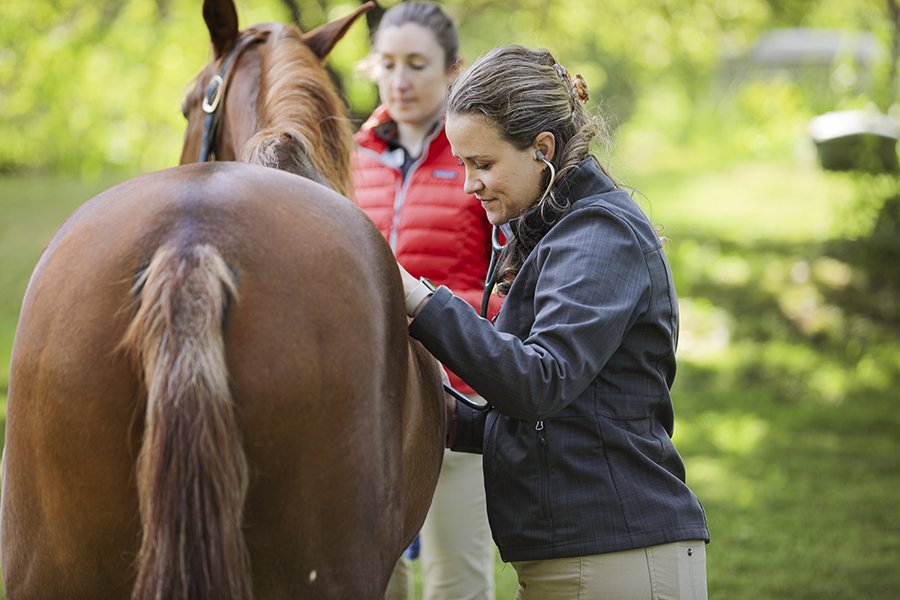
Vaccination Recommendations
Home > Client Resources > Vaccination Recommendations
Vaccines protect horses from disease by increasing circulating levels of certain antibodies in the blood. Most vaccines require two doses, 2-4 weeks apart when given for the first time in a horse’s lifetime. Thereafter, boosters are required to maintain immunity each year. Below are listed the vaccines most commonly given. We recommend that all horses receive EEE/WEE/tetanus, West Nile Virus, and Rabies annually, as bare minimum protection.
EEE/WEE
EEE (Eastern Encephalomyelitis) and WEE (Western Encephalomyelitis) are fatal viral diseases transmitted by mosquitoes, which can affect humans as well as horses. Signs include profound neurologic disease and acute death. Treatment for encephalitis is rarely successful. Annual vaccination prior to mosquito season is recommended. In particularly warm years, a second booster in the fall may be warranted as the vaccine provides protection for 4-6 months.
Tetanus
Tetanus is a bacterial infection associated with wounds, especially punctures. Treatment is rarely successful. Initially, horses receive two doses of vaccine 3-4 weeks apart followed by an annual booster.
West Nile Virus
West Nile is a virus that can cause devastating neurologic disease, especially in unvaccinated horses. The virus is carried and passed through the bites of mosquitoes and is amplified in birds, which can harbor the virus for long periods of time. Horses sick with West Nile Virus show neurologic signs that can mimic EPM or other diseases. About 40% of affected horses die or are euthanized if affected by West Nile virus. Although cases can be seen any time that mosquitoes are active, the majority of cases occur in late summer and early fall. The vaccine is safe for use in all age groups, including pregnant mares. Initially, horses must receive two doses of vaccine 3-6 weeks apart. Thereafter, we recommend two boosters each year, in the spring and in late summer.
Rabies
All pet animals and livestock are required to be vaccinated against this fatal disease. If an unvaccinated animal is exposed to a rabid animal, New York State recommends euthanasia. The only alternative is a 6 month period of observation in a state approved isolation facility. If a vaccinated animal is bitten by or comes in contact with, a rabid animal, they must receive a booster Rabies vaccine within 5 days of the exposure. Initially, horses must receive two doses of the vaccine 3-4 weeks apart. Thereafter, the vaccine is given once a year.
Potomac Horse Fever
Potomac Horse Fever (PHF) is caused by Neorickettsia risticii bacteria that is transmitted by a trematode (aka a fluke) which completes a life cycle through freshwater snails and aquatic insects, such as caddisflies and mayflies. Horses that inadvertently ingest insects or snails that contain infected flukes can develop depression, fever, inappetence, diarrhea, and laminitis. A small number of horses die from this disease each year. The vaccine we have available does not evoke a long-lasting increase in antibody levels. Initial vaccination is given in 2 doses 3-4 weeks apart. In areas that we know have had severe PHF cases in the past, we recommend vaccinating every 2-3 months during the warm season. In areas that have not had severe PHF, vaccinating twice a year is recommended in spring and midsummer.
Rhinopneumonitis (Equine Herpes Virus or EHV-1 and EHV-4)
“Rhino” is a multi-strain viral disease, that depending on the strain of virus involved, can cause respiratory disease, neurologic disease, and abortion in horses. Vaccination against Rhino has not been shown to provide consistent protection against the neurologic form of the disease, known as Equine Herpesvirus Myeloencephalopathy (EHM). Rhino vaccines can contain various combinations of strains and vaccination against both EHV-1 and EHV-4 is recommended. The immunity conferred by the Rhino vaccine is short lived, so depending on risk level, the vaccine is administered 2-4 times a year. Your veterinarian will guide you in choosing the best vaccine and protocol for your horse.
Influenza (Flu)
“Flu” is a highly contagious viral disease that can cause high fevers and respiratory disease. There are two forms of Flu vaccine, a modified live intranasal vaccine, and a killed intramuscular vaccine. The immune response to the intramuscular vaccine is short lived, so at risk horses are vaccinated every 6 months. The intranasal vaccine provides good protection when given once a year. Both vaccines require two initial doses 3-4 weeks apart.
Strangles
Strangles is a highly contagious bacterial disease characterized by high fever, thick nasal discharge, and lymph node abscessation. While rarely fatal, horses can require weeks of recuperation and nursing care in strict quarantine. There are two types of vaccine available to protect your horse against this disease. An intramuscular vaccine provides adequate elevation of circulating antibodies and superior levels in colostrum but often causes short-term painful reactions in the area of administration. We prefer the two-tier immunity conferred by the intranasal vaccine that boosts both circulating and mucosal antibody levels. Horses that travel or come in contact with traveling horses and farms with histories of outbreaks should use this vaccine annually. Vaccination is initiated by two doses given 2-3 weeks apart for the intranasal vaccine and 3-4 weeks apart for the intramuscular vaccine.
Botulism
Toxins from the bacteria Clostridium botulinum causes this paralytic disease. We have seen cases in our area associated with contaminated bedding and carrion inadvertently getting baled into hay. As this disease is costly to treat and can be fatal, vaccination should be considered for horses being fed large bales of hay that are not being carefully inspected for contamination. Because foals are highly susceptible to the toxin, we recommend vaccination of all broodmares on an annual basis 30 days prior to their foaling date, so that their colostrum will provide protection to the foal. The first year, three doses of vaccine are given one month apart. In subsequent years, a single dose booster is given.
Lyme Disease
Deer ticks transmit the bacteria, Borrelia burgdorferi, that causes Lyme disease through their bite. A wide variety of maladies has been attributed to this disease that can be life and/or performance threatening. We have used a canine vaccine off-label for many years with good results and no safety problems. Initially, three vaccines are given over a 3 month period. Thereafter the vaccine is given twice a year in early spring and late summer/early fall. Recent studies suggest that a higher dose of the vaccine injected intradermally provides higher antibody levels.
Rotavirus
This virus causes extremely contagious, potentially life-threatening diarrhea among groups of young foals. This vaccine will provide immunity through the colostrum in mares that are vaccinated on an annual basis with three doses one month apart beginning 90 days before their due date.
Leptospirosis
This bacterial disease, caused by the spirochete Leptospira, is linked to abortions and uveitis, also known as “moon blindness,” in horses. Horses, dogs, and people can become infected by ingesting water or feed that has been contaminated by deer urine. There is now a vaccine against leptospirosis licensed specifically for horses. Initially, two vaccinations need to be given 3-4 weeks apart. Thereafter, an annual booster is required. The vaccine is safe for use in pregnant mares.
